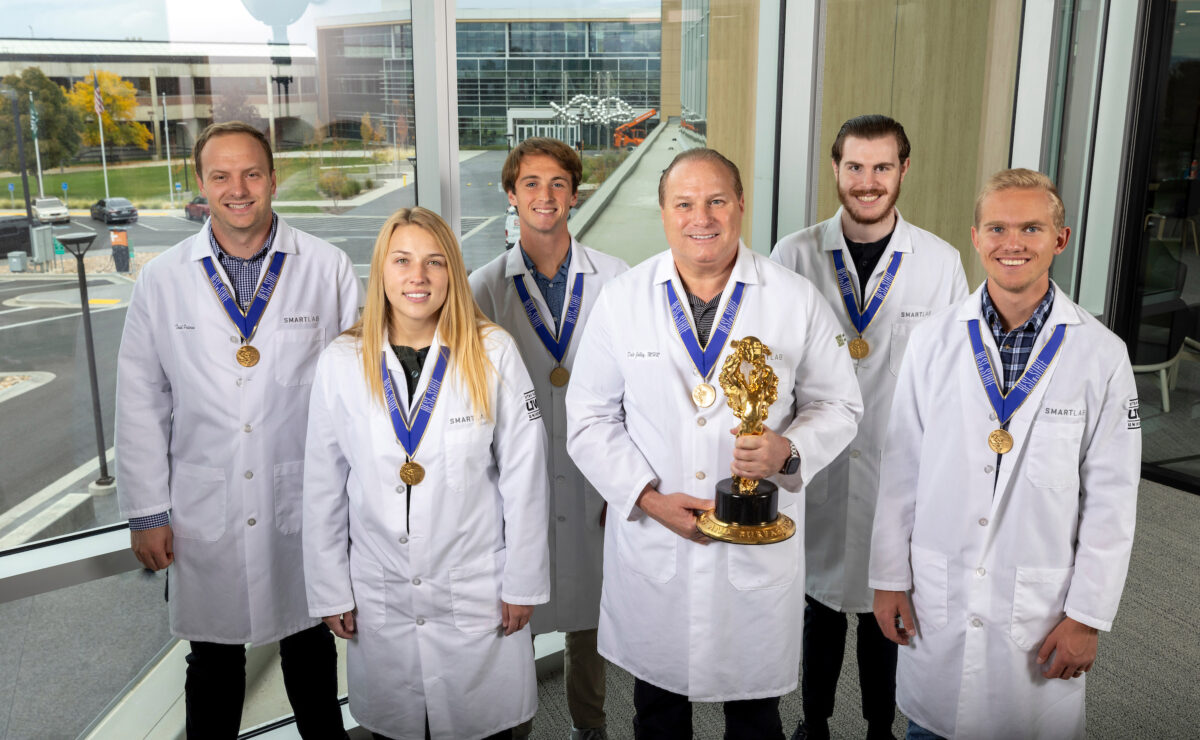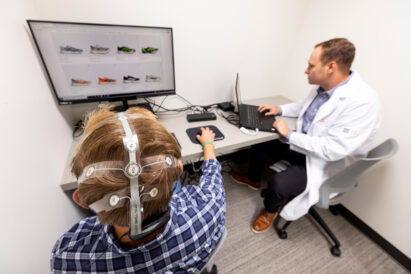UVU: SMARTLab merges neuroscience, marketing to decode human behavior
- Brain waves are measured as part of research into various marketing methods at Utah Valley University’s SMARTLab.
- Utah Valley University’s SMARTLab has won 10 consecutive Utah Best of State awards for analytical labs.
- Skin response tracking is used as part of research into marketing methods at Utah Valley University’s SMARTLab.
- Eye tracking glasses are used as part of research into various marketing methods at the Utah Valley University SMARTLab.

UVU Marketing
Brain waves are measured as part of research into various marketing methods at Utah Valley University’s SMARTLab.
At Utah Valley University (UVU), student and faculty researchers are uncovering the subconscious influences on consumer behavior and translating them into insights businesses can use to improve their marketing.
Inside UVU’s SMARTLab, short for Sales and Marketing Applied Research Test Lab, students and faculty are using neuroscience tools once reserved for medical and psychological research to uncover what truly resonates with consumers. Whether it is a website design, a product package or a sales pitch, the lab can reveal in real time what parts are capturing visual attention and how people feel, think and react to them.
“This is the future of consumer research,” said Dale Jolley, director of the SMARTLab. “The technology allows us to see not just what people say but what their brains and bodies are telling us. That’s powerful.”
The SMARTLab was founded in 2014 through a $2 million partnership between UVU, Vivint and company founder Todd Pedersen. At the time, it was one of the first labs of its kind in the Intermountain West and remains one of the most advanced university-based marketing research centers in the country.
Its purpose is twofold: to give businesses hard data about consumer behavior and to immerse students in the most advanced, high-level, hands-on research. In doing so, UVU has created a hub where academia and industry meet, benefiting both.

UVU Marketing
Utah Valley University’s SMARTLab has won 10 consecutive Utah Best of State awards for analytical labs.
Traditional marketing research relies on focus groups and surveys, methods that are vulnerable to bias and incomplete recall. The SMARTLab eliminates that guesswork by measuring subconscious reactions.
Among its core technologies:
- Eye Tracking: Maps exactly where and how long people look at screens, products or real-world environments, including wearable glasses for in-store testing.
- EEG (Electroencephalography): Measures brainwave activity to identify engagement, mental workload and emotional responses.
- Galvanic Skin Response (GSR): Tracks subtle changes in skin conductance to reveal emotional arousal.
- Facial Coding: Analyzes micro-expressions to detect emotions like joy, confusion or contempt.
- Traditional Focus Groups: Adds qualitative insight to biometric data, giving clients a fuller picture of consumer reactions.
Using these tools in combination — such as EEG plus eye tracking — allows researchers to pinpoint precisely where a campaign succeeds or fails.
Over the years, the SMARTLab has tackled a wide variety of studies for companies big and small. For one client, eye-tracking revealed that website users struggled to find a checkout button, leading to a redesign that boosted conversions.
Another study showed that children-focused ads outperformed celebrity endorsements, reshaping a company’s messaging. Their most recent study revealed the impact of AI-generated deepfake videos and generated an advertising value equivalent (AVE) of $2 million dollars for the university.
UVU Marketing
Skin response tracking is used as part of research into marketing methods at Utah Valley University's SMARTLab.
Other projects have included:
- Discovering that consumers preferred simpler product packaging with larger print.
- Showing that digital billboards attracted more attention than static ones, but that rapid image changes caused irritation.
- Mapping shopper behavior in showrooms, identifying distractions and key engagement patterns.
- Using facial coding to reveal confusion and distrust during flawed sales presentations.
These insights are not just academic, they have saved companies thousands, if not millions, of dollars in wasted campaigns.
The SMARTLab has earned multiple awards for its work, which include 10 consecutive Utah Best of State awards for analytical labs, and it is increasingly recognized on an international stage.
On average, the lab runs more than 60 studies a year with over 1,700 participants annually, impacting more than 16,000 students and professionals since its inception.
For UVU students, the SMARTLab is more than a research facility, it is a career launchpad. Students work side by side with national brands such as Adobe, Overstock, Skullcandy, and Lion Energy, gaining practical skills that translate directly into jobs.
UVU Marketing
Eye tracking glasses are used as part of research into various marketing methods at the Utah Valley University SMARTLab.
“This gives our students unparalleled access to the latest advancements in marketing research,” Jolley said. “They’re not just learning theory. They’re applying it to real business problems.”
That hands-on experience has helped graduates land roles in market research, analytics and brand management or continue into advanced graduate programs. Students also leave with stories that stand out — like using $30,000 eye-tracking glasses to analyze shopper behavior or testing brainwave activity during an ad campaign.
The SMARTLab exemplifies UVU’s blend of practical education and innovation. It also reflects a larger shift in marketing, where data, not instinct, drives decisions.
“We can see what’s working and what’s not through data-driven insights,” Jolley said. “That’s the future of marketing, and our students are leading the way.”





